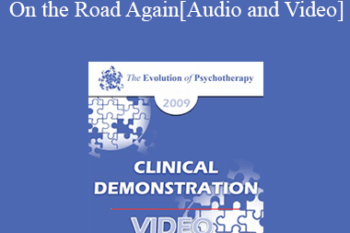Achieve more with the NICABM – How to Work With Clients Who Are Stuck course, priced at just Original price was: $97.00.$90.00Current price is: $90.00. on GBESY.biz! Explore our extensive collection of over 60,000 downloadable courses in Everything Else. We offer professional, self-paced digital education at up to 80% off original rates. Start transforming your expertise now!
 The National Institute for the Clinical Application of Behavioral Medicine is a pioneer and leader in the field of mind-body-spirit medicine. As a provider of continuing education for health and mental health care professionals for over 20 years, NICABM is at the forefront of developing and delivering programs with “take home” ideas, immediately adaptable for practitioners to use with their patients.
The National Institute for the Clinical Application of Behavioral Medicine is a pioneer and leader in the field of mind-body-spirit medicine. As a provider of continuing education for health and mental health care professionals for over 20 years, NICABM is at the forefront of developing and delivering programs with “take home” ideas, immediately adaptable for practitioners to use with their patients.
NICABM – How to Work With Clients Who Are Stuck course with special price just for you: $97 $92
 NICABM – How to Work With Clients Who Are Stuck
NICABM – How to Work With Clients Who Are Stuck
The National Institute for the Clinical Application of Behavioral Medicine is a pioneer and leader in the field of mind-body-spirit medicine. As a provider of continuing education for health and mental health care professionals for over 20 years, NICABM is at the forefront of developing and delivering programs with “take home” ideas, immediately adaptable for practitioners to use with their patients.
Product Info
How to Disrupt the Powerful Barriers That Keep Your Client Stuck
Why do clients get stuck?
To fully understand what keeps our clients at a standstill, we need to look deeper at what causes the neurophysiological patterns that lead to gridlock, and how the unconscious brain creates biases that keep our clients immobilized.
And we need to look at new ways to approach the core fear that traps our clients inside a holding pattern of stagnation.
So we sat down with 15 of the greatest experts in our field to ask them how they work with clients who are stuck. This is what they told us. . .
How the Unconscious Brain Creates a Holding Pattern of Fear
Bessel van der Kolk, MD Joan Borysenko, PhD Bill O’Hanlon, LMFT
•How chronic trauma changes the brain (and why it keeps patients stuck)
•How specific neural changes alter the way clients build connections
•How one practitioner shifted himself from fearful avoidance to spontaneity
How to Rewire the Rigid Mind
Rick Hanson, PhD Kelly McGonigal, PhD
Joan Borysenko, PhD Bill O’Hanlon, LMFT
•The “mo-betta” approach to positive neural linking
•How to increase a client’s learning rate from positive experiences.
•How the “dreaded experience” can make your client stuck
•How to pick out the subtle ways your client is stifling self-expression
One Practical Skill to Locate Where Your Client is Stuck
Marsha Linehan, PhD Joan Borysenko, PhD
•What happens when practitioners mistake impulse for choice
•The analytical technique that motivates a client to change
•How to focus an assessment to help clients identify their own stuckness
How to Work With the Procedural Memories Keeping Your Clients Stuck
Pat Ogden, PhD Joan Borysenko, PhD
•How to access specific memories in the body that cognitive therapy can’t reach
•The procedural patterns of trauma vs. attachment: why they require two different approaches
•How to foster integration between the explicit and implicit selves
How to Help Clients Defuse Limiting Ego Strategies
Tara Brach, PhD Ron Siegel, PsyD Kelly McGonigal, PhD
•The “Spacesuit Self”: why clients put it on (and why it’s so hard to take off)
•How to approach stuckness when it’s layered with shame
•The “stop signal” that can disrupt anger and invite choice
How to Sell Your Client on Change
Marsha Linehan, PhD Ron Siegel, PsyD Kelly McGonigal, PhD
Joan Borysenko, PhD Bill O’Hanlon, LMFT
•The one critical part of therapy where many practitioners fall short
•The one emotion that you need to reframe as your client’s worst enemy
•One practical skill that can break clients out of negative patterns
How Post-Traumatic Memories Can Hold the Body Hostage
Peter Levine, PhD Ron Siegel, PsyD Bill O’Hanlon, LMFT
•How the body’s unconscious reaction to trauma keeps clients stuck
•Why trauma survivors often get stuck in a brain-body feedback loop
•The key factor that helps the body release stuck trauma and restore itself
How to Work With the Behavioral Patterns That Suppress Growth
Richard Schwartz, PhD Ron Siegel, PsyD Kelly McGonigal, PhD
•The Internal Family Systems model for helping clients get unstuck
•How to help clients form corrective relationships with their extreme sub-personalities
•The important negotiation process that allows you to reach a client’s stuck parts
How to Use Neuroplasticity to Overwrite Negative Beliefs
Rick Hanson, PhD Bill O’Hanlon, LMFT
•12 seconds that can make a difference for positive brain change
•Why positive experiences alone are insufficient (unless you follow them up with this one step)
•The important phase of brain change that practitioners routinely overlook
How to Motivate Clients to Push Through Self-Imposed Boundaries
Kelly McGonigal, PhD Ron Siegel, PsyD Bill O’Hanlon, LMFT
•The cocoon effect and how it keeps clients stuck
•How to use the “missing zero” strategy to motivate change
•How to help clients assess the real cost of avoidance
Why Your Client May be Feeling Constrained and How to Help Free Them
Jack Kornfield, PhD Ron Siegel, PsyD
Kelly McGonigal, PhD Joan Borysenko, PhD
•How to adjust an intervention when arousal overwhelms the client
•A strategy to help clients make more empowering decisions
•How to help clients regain a new sense of self after trauma
How to Help Clients Rewrite Their “Stuck Story”
Joan Borysenko, PhD Bill O’Hanlon, LMFT
•One of the most powerful patterns that keeps people from change
•The 10,000-hour plan to becoming stuck
•One way to help clients escape the prison of their grievance stories
Salepage : NICABM – How to Work With Clients Who Are StuckArichive : NICABM – How to Work With Clients Who Are Stuck
How to Work With Clients Who Are Stuck|NICABM|NICABM – How to Work With Clients Who Are Stuck
Invest in endless knowledge with the NICABM – How to Work With Clients Who Are Stuck course at GBESY.biz! Gain lifetime access to premium digital content designed to fuel your professional and personal growth.
- Lifetime Access: Unrestricted, permanent access to your purchased courses.
- Unbeatable Value: Save significantly with prices up to 80% less than direct purchases.
- Protected Payments: Complete your transactions securely.
- Empowering Skills: Learn practical, in-demand skills for immediate application.
- Immediate Download: Access your course content instantly after purchase.
- Any Device, Anywhere: Study on your preferred device with full flexibility.
Discover your next opportunity with GBESY.biz!
![GBesy [GB] GBesy [GB]](https://gbesy.biz/wp-content/uploads/2023/05/gbesy-Logo-full-100.png)
![GBesy [GB] GBesy [GB]](https://www.gbesy.com/wp-content/uploads/2023/05/gbesy-Logo-full-100.png)



 Purchase this course you will earn
Purchase this course you will earn 



Reviews
There are no reviews yet.